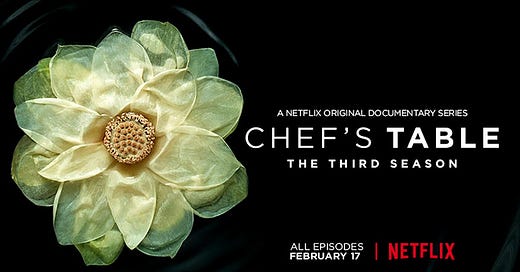Have you ever subscribed to a streaming service to watch one very specific program or episode? I have. Once. Chef’s Table Season 3, Episode 1 on Netflix.
Vocabulary of the Day:
스님 (snim): Buddhist monk
목사님 (mok-sah-nim): (Christian) minister, pastor
신부님 (shin-boo-nim): (Catholic) priest
Remember the 스님 word, for I’ll be making reference to this word all throughout today. A rule about Korean grammar when you’re calling to someone in clergy by name. Their (given) names come first and then you attach whatever appropriate word from the above list.
For example, the Chef’s Table episode featured a Buddhist nun named Jeong-kwan (정관). Her birth name is 박애자 (Bak Ae-ja)—and Jeong-kwan is her given Buddhist name when she entered “the Way” of a Buddhist nun when she was 17 after her mother passed away in 1974.
In Korean vernacular of honorifics and whatnot, you MUST call her Jeong-kwan snim, 정관스님, never, ever, just “Jeong-kwan.” If you’re ever at the temple where she’s at (information to follow), remember to call to her as “정관스님,” or just “스님.” Although I get the feeling that she’d be the last person to care about the proper usage of honorifics.
I wish someone would do a walking video of the pathway leading up to Baek-yang-sa but this YouTube video will have to do (until I do it myself).
Forget everything else. The cinematography alone is worth the price of admission. When I first heard of the show, my question was, how the hell did Netflix find out about her? I mean, she was almost unknown even in Korea—the only reason I had vaguely heard about her was because I *used to* read up on the world of fine-dining and the famous chefs (I’ve never been to any of them, though).
When I saw Eric Ripert, head chef and owner of the famed Le Bernardin in New York, making an appearance, I thought it must have been him who had a hand in this episode being produced. When someone like Ripert gets involved in any kind of show about cooking, you have to pay attention, right?
Monsieur Ripert held a special event in 2015 for 정관스님 at his Michelin 3 star restaurant and the New York Times food writer Jeff Gordinier was there, despite his initial decline to the invitation.
He called the experience “life-changing,” and “this was as good as any meal you can get from any chef on the planet.” For some of the other remarks he’s made about Jeong-kwan and her creations, you’re going to have to watch the show on Netflix.
If you have a Netflix account, please do look it up and watch it. The 55-minute show will not disappoint.
Oh, and by the way, the title screenshot of the whole Season 3 at the top of this post is a picture of the Lotus flower (연꽃) tea prepared by 정관스님.
I’ve previously talked about how I wanted to take a month off from parenting, husbanding, son-ing when my youngest is off to college later this year, and fulfill some of my top bucket list items. Temple stay somewhere in remote part of Korea is one of them. With my first daughter at UCLA, second one at Berkeley and youngest having committed to Stanford (I must be the luckiest SOB in the world), all three in STEM, I should be able to go sometime this fall, or next spring, but I’m not entirely sure if it’s actually going to happen.
But I did indeed look up some stuff.
Templestay.com is a Korean website available in English operated by the Cultural Corps of Korean Buddhism. As you can sort of see in the above screenshot, the number of temples you can choose are shown on the map by region (Province). There are a lot more temples available for stays on the Korean language version, probably implying that the ones listed here have English programs.
Remember, South Korea is a small country, especially if you’re from the US. From one end to the other end (Seoul to Busan), not including Jeju Island, is only about 200 miles (~ 320km) in a straight line. But there’s the sort of “last mile” problem getting to these temples because they are almost all deep in the mountains. The website, however, provides all the detailed information about how to get there.
So, where is the temple that Jeong-kwan snim is at? It’s called Baek-yang-sa (백양사, the -sa suffix means “Temple”) and in the “Gwangju, Jeonnam” area on the above map.
I’ve gone through the list of the temples that are on the website and they’re all very famous temples in terms of history, location, and beauty. A few of them are more than 1300 years old. Baek-yang-sa is known to have originally been built in 632, about 1400 years ago. You shouldn’t go wrong with any of them—although I really don’t know because I don’t have any firsthand experience.
Follow the appropriate links (it’s intuitive), and when you click on the Reservation button, you will be taken to…
Other than a few slightly awkward translations, the website is very informative and easy to use. Although… (at the risk of sounding blasphemous, I dare say…) the 160,000 KRW (~$120) price tag per person per night did seem a little too… “commercial.” It does include 3 meals, so maybe it’s worth every penny, I just don’t know…
Finally, to provide some guideposts, the ones that would be at the top of my list for an overnight visit would be, not in any particular order,

















Your Haeinsa Buddhist Temple is not on this list but it still strikes me as one of the most remarkable places to visit.